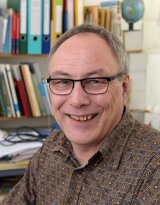Room 212/213
Löbdergraben 32
07743 Jena

Sediments in a dried out reservoir, South Africa
Image: J. Baade 2018Soil erosion is the most significant quasi-natural sub-process of land degradation and a global problem. Soil erosion, in particular by water, leads to the erosion of the topsoil, the fragmentation of landscapes and sediment input into the water systems. In arid areas, this also causes the silting up of drinking water reservoirs and a corresponding decrease in the storage volume.
TLS-Vermessung von Tiefenlinienerosion
Image: J. Baade 2015The objectives of the Working Group on Soil Erosion within SALDi are:
1. To improve the assessment of the extent of soil erosion in South Africa by means of current studies on the silting up of reservoirs.
2. To evaluate the extent of soil erosion in relation to soil recharge rates (TP3).
3. To improve the model-based estimation of soil erosion by water with a physically based model.
Gully erosion (DTM)
Image: Jussi Baade/FSU 2017Recent measurement of the extent of soil erosion is an approach to correctly assess the problem. Another approach is to estimate soil erosion using models. But such models usually need to be adapted or calibrated. This in turn requires direct measurements of soil erosion. Here we will use cross-scale measurement methods from locally very limited measurements by means of a terrestrial laser scanner (TLS), over threat-supported photogrammetry up to satellite-supported approaches. Common to all approaches is the goal of correctly locating the focal areas of soil erosion across scales.
Reservoir survey at Klipkopjes Dam, White River, Mpumalanga
Image: J. Baade 2020The material that is removed from the catchment areas collects over decades in reservoirs. In view of the strongly fluctuating weather conditions under semi-arid climatic conditions, long-term geo-archives, such as reservoirs, are particularly valuable when it comes to determining average erosion rates. Within the framework of SALDi, it is planned to explore selected reservoirs in several working areas, to investigate the state of siltation by means of echo-sounding and to determine the mean sediment input rates and soil erosion rates from the data.
Soil Erosion Modelling
Image: SALDi 2020In SALDi the adaptation of the physically based erosion model Erosion3DExternal link (Schmidt 1996, Schob et al. 2006) to the conditions in South Africa puts soil erosion modelling on a new footing. Currently we are evaluating to which extent readily available data can be utilized to drive the erosion model for a small catchment close to Ladybrand, Free State.
In the field of soil erosion research, we work closely with TP2 and TP3 in Germany. In South Africa, the cooperation focuses on the ARC-ISCW, SANParks, the University of the Free State and the North West University.
Milestone 1: 1st field campaign for reservoir surveys, rainfall experiments (in collaboration
with ARC) and TLS surveys conducted
Milestone 2: Reservoir surveys analyzed
Milestone 3: 2nd field campaign for rainfall experiments (in collaboration with ARC) and TLS resurveys conducted
Milestone 4: Results of rainfall experiments integrated in EROSION 3D and prototype of
EROSION ZA developed together with ARC-ISCW
Milestone 5: TLS surveys analyzed and results compared to aerial photography
Milestone 6: Medium-term sediment yield and soil loss rates derived from reservoir surveys, decadal trends of soil erosion established
Milestone 7: Contribution to capacity building completed with 2nd SALDi Summer School in Stellenbosch
Milestone 8: Final results presented at SALDi balance meeting in Pretoria
Room 212/213
Löbdergraben 32
07743 Jena
